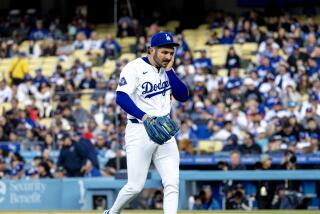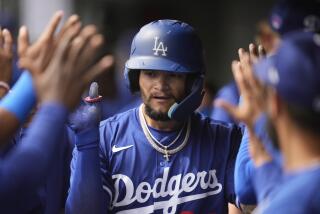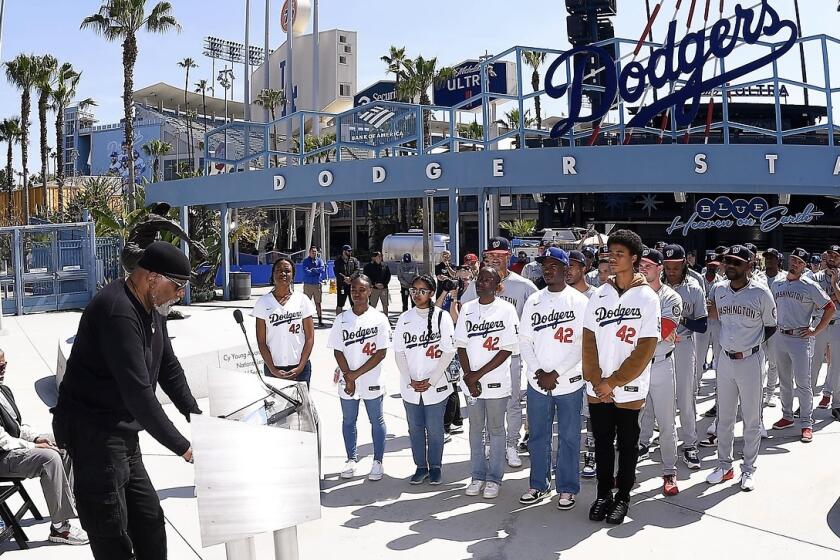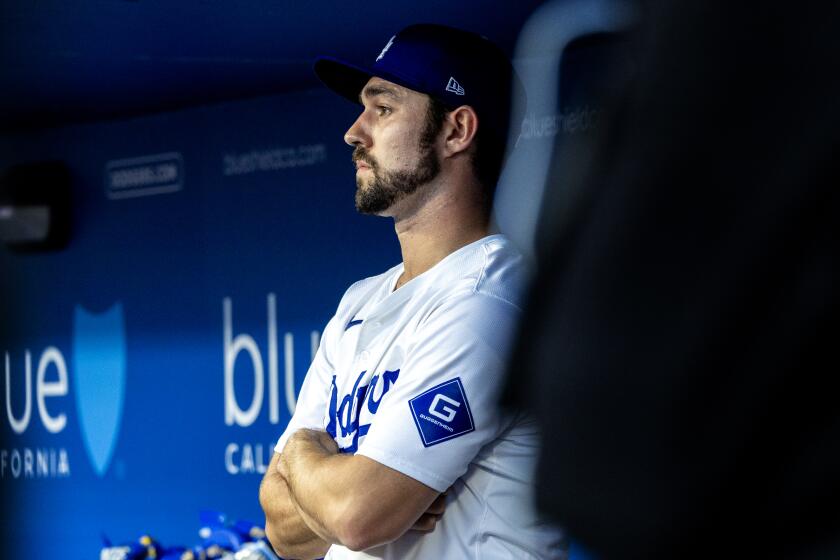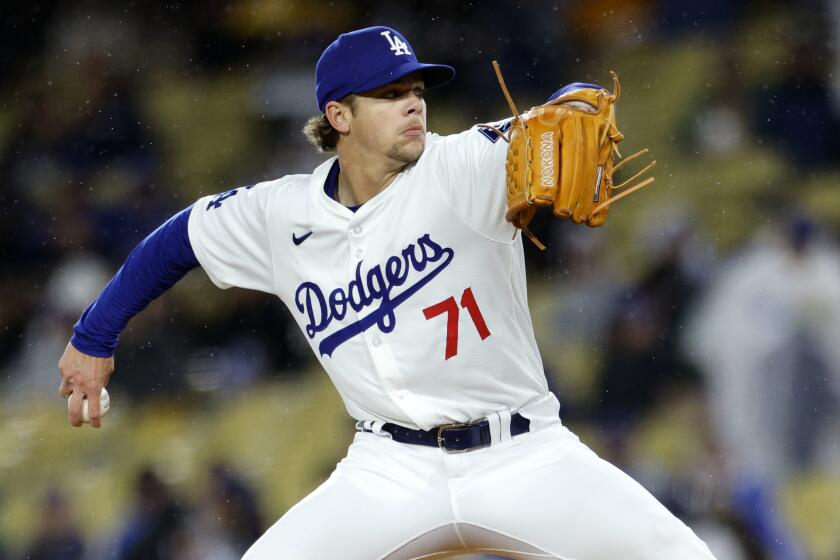Pitching coach is part counselor, part mentor, part best friend
The clubhouse is all but empty when Rick Honeycutt reports to work. It’s six hours before the first pitch, but he’s already pressed for time.
The Dodgers’ pitching coach has two hours of video to review from the previous night’s game before he can start preparing for that night’s opponent.
“I can’t count the number of times I’ve walked past that video room and his back is to the door in front of the video screen,” reserve catcher Brad Ausmus said.
It’s a job done largely in isolation. And, based on percentages, even the best end up getting it wrong at least 40% of the time.
There are some victories, though, that make it all worthwhile. Honeycutt enjoyed one Sunday when left-hander Clayton Kershaw held the Colorado Rockies to two hits in eight shutout innings. Kershaw’s previous start was among the worst in his young career, the Milwaukee Brewers tagging him for seven earned runs in 1 1/3 innings.
“We did our work,” Honeycutt said of the adjustments Kershaw made. But, like most good pitching coaches, he refused to say exactly what that entailed.
Few jobs in baseball are as misunderstood as pitching coach, partly because the coaches toil under a cloak of secrecy that CIA operatives would admire. But when they fail — or, more accurately, when their pitchers fail — it’s the coach who often becomes the target of scorn and criticism in the blogosphere and on sports-talk radio.
“Managers and coaches often get too much credit and too much blame,” said Randy Wolf, who last season led the National League in starts and posted his best earned-run average in seven seasons under Honeycutt before signing as a free agent with the Brewers. “I’ll never blame a pitching coach because I’m almost positive a pitching coach has never thrown a pitch for me.”
Some pitching coaches say their job title is misleading because, with countless hours of video work, tedious bullpen sessions and long game-planning meetings, they spend very little time coaching pitching.
“It’s very, very difficult to change a pitcher’s mechanics when they’re 18, let alone 28,” Angels Manager Mike Scioscia said.
Added Mike Butcher, in his fourth season as the Angels’ pitching coach: “By the time most guys get here, they’re their own personal coach. They should understand themselves very well.”
There can be some tinkering to do, however. A current Butcher project is left-hander Scott Kazmir, who is 2-3 with a 6.82 ERA in six starts. Kazmir emerged from a meeting with his coaches Wednesday with new drills designed to help him relocate his proper arm slot.
But a pitching coach most of the time is a counselor, confidant, babysitter, best friend or mentor. Sometimes, all of the above.
“Yeah, you’ve got to do some counseling,” Butcher said. “You get to know these guys on a professional level. You get to know these guys on a personal level. And you try to work all those things in together and take them out on the field.
“I understand what every guy needs on our pitching staff. Some guys need a little bit more, some guys need a little bit less. Some guys you can jump on, some guys you can’t jump on. And it’s what’s going to make that guy click in a game.”
That’s why Rick Adair, whose Seattle staff was the best in the American League last season, studies his pitchers’ personalities as much as their windups.
“You look at their backgrounds. Where they grew up. Their family backgrounds. What’s important for them and how that mind-set has been developed from the time they were born,” he said. “That has a lot to do with how you approach a guy.”
At best, it’s an inexact science. Angels pitcher Joel Pineiro, who resurrected his career in St. Louis under pitching coach Dave Duncan, struggled to explain exactly what Duncan did to help.
“I don’t know,” Pineiro said. “He didn’t change my mechanics. I think it’s more mental and the way he prepares you for your starts, for your games. His book reports, his scouting report — just top-notch, I guess.
“The way he prepares you mentally and tells you just to attack the strike zone and not be afraid to get hit. It works.”
It works for Honeycutt too. Although Duncan is widely recognized as baseball’s best pitching coach, it was Honeycutt’s staff that led the majors both with a 3.41 ERA last year and with a 3.88 mark over his four seasons with the team.
Through Wednesday’s game, the team’s ERA this season is 4.68, eighth worst in the majors, although Honeycutt isn’t doing much differently — except maybe working harder. But then, that number is down from 5.69 after the Dodgers’ 9-0 loss to San Francisco on April 17.
The turnaround began in earnest with Sunday’s game as Kershaw outdueled the Rockies’ Ubaldo Jimenez for a 2-0 victory. In their last four games, the Dodgers have a 2.00 ERA.
“At the end of the season, or somewhere in the future if they’re not responding, then obviously my methods aren’t working,” Honeycutt said. “But in my first four years I’ve been here, we’ve done pretty well.”
Watching video, Honeycutt looks for hitters’ “chase zones” — areas where hitters will reach for a pitch that often results in a swing and a miss. And he studies how hitters react on certain pitch counts.
“For us, it’s easy because we just have to find out what we can do to get people out,” Kershaw said. “For a pitching coach, he’s got to look at everybody as a whole, so it’s hard.”
Honeycutt also looks at how Dodgers pitchers have fared against particular hitters before, to see what has worked and what hasn’t. If he needs more video evidence, he will find pitchers who are similar in style and study games they pitched against the same opponent.
“His job also is to make sure you’ve got a positive outlook on things more so than stressing over what might be wrong,” Dodgers reliever Jeff Weaver said.
If his pitcher has been going well, Honeycutt’s work might be cut short. But if his guy has been struggling he might prepare a clip to illustrate what might be off: a pitcher’s release point, stride or footing on the mound.
In those cases, Honeycutt speaks from experience. After all, he lost 143 games during a 21-year big league career.
“The approach that he has with the pitchers, and especially to me, is that he has so much information, so much data, and he lets me choose,” Dodgers starter Hiroki Kuroda said through an interpreter, “He doesn’t tell you, ‘Do this, do that,’ but he gives you a lot of options for me to choose from.”
The studying doesn’t stop once the game starts. If a certain hitter is having a lot of success, Honeycutt will return to the video room between innings to see which pitches are working and which ones aren’t. But adjustments can be tricky, which is why few occur during a game.
Should concentration fade or the tempo need to change, Honeycutt often will send the catcher to the mound.
“If Honey sees something mechanically or something that somebody’s doing wrong, he’ll let me know during the game so I can go tell the pitcher, like pulling off or if they’re not following through the right way,” Dodgers catcher Russell Martin said.
“A horse and a jockey,” Butcher, a former big league reliever, said of the pitcher-catcher relationship. “Sometimes pitchers are the worst evaluators on their stuff. We talk to the catchers as much, if not more, than the pitchers during a game.”
For Butcher, whose starters led the majors with 291 wins in his first three seasons with the Angels, it has been a challenging spring. Not only will his team open Friday night against the Oakland Athletics with a losing record, but it will do it with an ERA (4.96) that is the fifth worst in the majors. And the Angels are tied with Kansas City for the AL lead in walks given up with 152.
Still, there’s only so much Butcher can do before he hands the ball off and hopes for the best.
“We’re not reinventing the wheel,” he said. “Basically, my job is to understand the guys’ delivery, understand their mental makeup, what makes them go. And try to minimize when guys are going wrong.”
It worked for Honeycutt and Kershaw. At least until his next start Saturday.
Times staff writer Jim Peltz contributed to this report.
Clicking on Green Links will take you to a third-party e-commerce site. These sites are not operated by the Los Angeles Times. The Times Editorial staff is not involved in any way with Green Links or with these third-party sites.
More to Read
Are you a true-blue fan?
Get our Dodgers Dugout newsletter for insights, news and much more.
You may occasionally receive promotional content from the Los Angeles Times.
